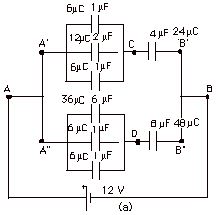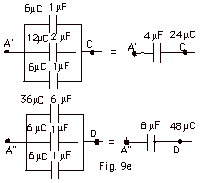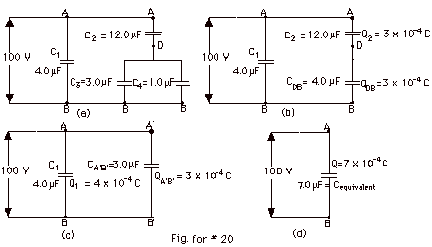|
Answers - Potential Energy, Potential,
and Capacitors
|
|
|
1.
|

- The distances from Q1 and Q2 to
P are r = (y2 + a2)1/2.
Since V is a scalar quantity, the potentials add algebraically.
V = k(Q1/(y2 + a2)1/2
+ Q2/(y2 + a2)1/2)
= k(Q1 + Q2)/(y2 + a2)1/2.
Since a is a constant, V is a function only of y.
- For y2 >> a2, V = kQ/y,
where Q = Q1 + Q2 which is the same
as the potential due to a point charge Q located at the
origin.
|
|
|
2.
|

- The potential V is a scalar quantity. In this case you
may use a minus sign to calculate the potential. For a point
charge Q, the potential at a point P a distance r from P
is V = (9 x 109 N-m2/C2)Q/r.
For q1, V1 = (9 x 109
N-m2/C2)(9 x 10-9 C)/3
m = 27 N-m/C
= 27 J/C = 27 V.
For q2, V2 = (9 x 109
N-m2/C2)(-1 x 10-9
C)/1 m = -9 V.
V at P = (27 - 9) V = 18 V.
- The potential at P is really the potential difference
between point P and a very large distance from P. At an
infinite distance, the potential due to q1 and
q2 is zero (r = a very large number), V∞
= 0. The work done to bring a charge q3 from
a very great distance to P is the increase of the potential
energy of the system. The potential difference VP∞
= the potential energy difference divided by q3 =
(UP - U∞)/q3.
Work done = q3VP∞ = q(VP
- V∞)= ( 3 x 10-9 C)(18
J/C - 0) = 54 nJ.
- For q2 = +1 nC,
V1 = (9 x 109 N-m2/C2)(9
x 10-9 C)/3 m = 27 N-m/C = 27 J/C = 27 V.
V2 = (9 x 109 N-m2/C2)(1
x 10-9 C)/1 m = 9 V.
V at P = (27 + 9). V = 36 V.
Now the work done = q3(VP - V∞)
= ( 3 x 10-9 C){(36 J/C) - 0} = 108 nJ.
|
|
|
3.
|

- In general, the potential due to a point charge Q at a
distance r is kQ/r.
For q1 = q2 = -200 x 10-6 C,
the potential at P is:
V = 9 x 109 N-m2/C2(-2
x 10-4 C)/√2 m
= -12.73 x 105 N-m/C
= -12.73 x 105 J/C
= -12.73 x 105 V.
For q3 = q4 = 100 x 10-6
C, the potential at P =
V = 9 x 109 N-m2/C2(10-4
C)/√2 m = 6.36 x 105 V.
Due to all the charges,
V = 2(-12.73 + 6.36)105 V
= -12.7 x 105 V.
- Work to bring q5 = 20 x 10-6 C from
infinity =
q5(VP – V¥)
= 20 x 10-6C(-12.7 - 0)105 V = -25.4
J.
|
|
|
4.
|

- The parallel plate capacitor with its charge and the particle
with the forces acting on it are shown in the figure above.
For the particle to be at rest, the net force acting
on it must equal zero: Fnet = ma = m(0).
Taking up to be positive, Fe - mg = 0
or Fe = mg, where the electric force on the particle
with charge q in an electric field E is Fe =
Eq. Thus,
Eq = mg or
E = mg/q = (10-3 kg)(9.8 m/s2)/(10-6
C) = 9.8 x 103 N/C.
The direction of the electric field is up. Remember
the direction of the electric field is that in which a positive
charge is urged.
- Vab = Ed = 9.8 x 103 N/C (10-3
m) = 9.8 J/C = 9.8 V.
|
|
|
5.
|

This is a problem in conservation of energy. The potential of
a sphere of charge equals the potential of a point charge =
kQ/r. When the alpha particle is a long distance away from the
gold nucleus initially i, the potential energy of the system
Ui is 0.
When the alpha particle touches the gold nucleus, r = 7.0 x
10-15 m = the radius of the gold nucleus. The
potential energy for the "final" position Uf
equals:
(9 x 109 N-m2/C2)(79)(2)
x (1.6 x 10-19 C)2/(7.0 x 10-15
m)
= 5.2 x 10-12 J.
From conservation of energy,
Ui + Ki = Uf + Kf
0 + Ki =
5.2 x 10-12 J + 0
|
|
|
6.
|
Ui +
Ki = Uf
+ Kf or
Ui - Uf = q(Vi - Vf)
= 1/2 mvf2 - 1/2 mvi2
1.6 x 10-19 C(100 J/C) = 1/2(1.67 x 10-27
kg)vf2 - 0
vf = (2 x 1.6 x 10-17 J/1.67 x 10-27
kg)1/2 = 1.38 x 105 m/s
|
|
|
7.
|
- For the -q and + Q system, the potential energy U = -kqQ/r
which remains constant if the distance r of separation of
the two charges remains constant.
- The electric force does no work because the force is always
perpendicular to the displacement of the negative charge
when it moves in a circular path around the positive charge.
Thus, there is no potential energy difference between points
along the circular path. The circle is an equipotential
path.
|
|
|
8.
|
Ua - Ub = q(Va
- Vb)
- For the proton,
Ua - Ub = 4.8 x 10-19 J
= (1.6 x 10-19 C)(Va - Vb)
(Va - Vb) = Vab =
(4.8 x 10-19 J)/(1.6 x 10-19 C) =
3.0 V.
- For the alpha particle,
Ua - Ub = q(Vab) = (3.2
x 10-19 C)(3.0 V) = 9.6 x 10-19 J.
|
|
|
9.
|

(a) VA = 9.0 x 109 N-m2/C2[80/0.10
- 60/0.10]10-9 C/m = 1.8 x 103 V
(b)
VB = 9.0 x 109 N-m2/C2[80/0.16
- 60/0.12]10-9 C/m = 0
(c) WB A
= q(VA - VB) = (10 x 10-6
C)(1.8 x 103 V - 0) = 0.018 J A
= q(VA - VB) = (10 x 10-6
C)(1.8 x 103 V - 0) = 0.018 J
|
|
|
10.
|

- If the kinetic energy of the object with charge q is to
remain constant, the net force acting on the object must
equal zero. For this to be true,
Fnet = F + qE
= 0,
where F is the force applied by the outside agent.
The work done in carrying the object from b to a without
increasing its kinetic energy producing a change in potential
energy difference = F . d = -qE .
d.
- Ua - Ub = -qE . d
= -qEd cos 180o = -qEd(-1) = qEd
=10-6C(104N/C)(0.10m) = 10-3
J.
- qVab = Ua - Ub = qEd.
Vab = Ed = (104 N/C)(0.10 m) = 103
V.
|
|
|
|
|
12.
|

- VB = kq1/1.0 m + kq2/3.0
m
= 9 x 109 N-m2/C2[(-4.0
x 10-6 C/1.0 m) +(2.0 x 10-6 C/3.0
m)]
= 3 x 103[-12 + 2]
J/C = -30 x 103 V
- VA = kq1/3.0 m + kq2/1.0
m
= 9 x 109 N-m2/C2[(-4
x 10-6 C)/3.0 m) + (2.0 x 10-6 C/1.0
m)]
= 3 x 103[-4 + 6]
J/C = 6 x 103 V
- Since no work is done to change the kinetic energy of
the particle, the work done to move q3 from B
to A =
UA - UB = q3(VA
- VB) =
(3.0 x 10-6 C)[6 - (-30)] 103
J/C = 0.108 J.
- The electric force is a conservative force so the work
done is independent of the path.
|
|
|
13.
|
- U = -ke2/r
- Fnet = ma
ke2/r2 = mv2/r or
mv2 = ke2/r
- E = U + K = -ke2/r + 1/2 mv2 = -ke2/r
+ 1/2 ke2/r = -ke2/2r
L = mvr
|
|
|
|
|
15.
|
- When capacitors are wired in parallel, the equivalent
capacitance
C = C1 + C2 + C3.
But, C1 = C2 = C3 = e0A/d,
so C = 3e0A/d
= e0A/(d/3).
The plate spacing for the single capacitor must be d/3.
- When capacitors are wired in series, the reciprocal of
the equivalent capacitance 1/C = 1/C1 + 1/C2
+ 1/C3 = 3/C1 and C = C1/3
= (e0A/d)/3
= e0A/3d,
so the plate spacing for the single capacitor must be 3d.
|
|
|
16.
|
For any capacitance, including C1,
C1 = Q/(Vab)i, where Q is the
charge on the capacitor when (Vab)i is
the potential difference across it. When the two capacitors
are wired in parallel, the potential difference across each
is the same = (Vab)f = q1/C1
= q2/C2, where q1 and q2
are the charges on C1 and C2 with potential
difference (Vab)f. Also from conservation
of charge q1 + q2 = Q or q2
= Q - q1 = C1 (Vab)i
- C1 (Vab)f = C1{(Vab)i
- (Vab)f}. But q2 also
equals C2 (Vab)f. Thus C1{(Vab)i
- (Vab)f} = C2(Vab)f
or since C1 = 4pe0R1
and C2 = 4pe0R2,
4pe0R1
{(Vab)i - (Vab)f}
= 4pe0R2(Vab)f
. Thus R2 = R1{(Vab)i
- (Vab)f}/(Vab)f.
|
|
|
17.
|
The capacitance of a parallel plate capacitor
in a vacuum C = eoA/d,
where A is the area of the plates and d is the distance between
them.
- When the plate separation is doubled:
- The capacitance C is halved since the capacitance
is inversely proportional to the distance d.
- C = Q/Vab or Q = CVab. When
C is halved and Vab remains the same (the
battery is still across the capacitor), the charge Q
is halved.
- E = s/eo.
When Q is halved, the charge per unit area s
is halved and E must be halved. Also E = Vab/d
so when d is doubled E is halved.
- When a dielectric with k=
2 is inserted:
- The capacitance = k
eoA/dso the capacitance is doubled.
- Q = CVab. When the capacitance doubles,
with constant Vab, the charge doubles.
- E = s/keo.
When Q doubles, s doubles,
but s/k
remains the same because k=
2 and E remains the same. Also E = Vab/d
so E is the same because Vab and d remain
the same.
|
|
|
18.
|

We may view the capacitor as three capacitors in series,
shown in Fig. for #18 above.
1/Ceq = 1/C1 + 1/C2 + 1/C3
= d1/Ae0
+ t/Ake0 +
d2/Ae0.
Ceq = Aeo/(d1
+ t/k + d2).
|
|
|
19.
|
 |
 |
To find the equivalent capacitance of
Fig. 9 we start with the original circuit.
The capacitors between A’ and C are in parallel so CA’C
= (1 + 2 + 1)µF = 4 µF. The capacitors between
A’ and D are in parallel so CA’D = (6
+ 1 + 1)µF = 8 µF, as shown in Fig. 9 b above.
The capacitors between A’ and B’ are in series.
1/CA’B’ = 1/4 µF + 1/4 µF
= 1/2 µF and CA’B = 2 µF,
as shown in Fig 9c.
The capacitors from A” to B” are in series so
1/CA”B’” = 1/8 µF +
1/8 µF =
1/4 µF and CA’B = 4 µF,
as shown in Fig 9c.
The capacitors between A and B (Fig. 9c) are in parallel and
CAB = 6 µF (Fig. 9d above).
Now work backwards to find the charge.
qAB = CAB VAB = 6 x 10-6
(C/v) 12 V = 72 x 10-6 C = 72 µC.
Up to Fig. 9c, qA’B’ = CA’B’
VA’B ’ = 2 x 10-6
(C/V) 12 V = 24 x 10-6 C = 24 µC. VqA”B”
= CA”B” VA”B”
= 4 x 10-6 (C/V) 12 V = 48 x 10-6 C
= 48 µC.
Notice qA’B’ + qA”B”
= (24 + 48)µC = 72 µC. The two capacitors from A’
to B’ are in series so each has charge = 24µC and
the two capacitors from A” to B” are in series
so each has charge = 48µC. VA’C = VDB’
= 24 x 10- 6 C/4 x10-6
C/V = 6 V.
 |
In Fig. 9e above, from A’ to C, the charge on the two
1µF capacitors is
q1µF = 1 x
10-6 C/V(6V) = 6 x 10-6 C = 6µC,
and the charge on the 2µF capacitor is
q2µF =
2 x 10-6 C/V(6V) = 12 x 10-6 C = 12µC.
In Fig. 9e, the charge on the 6µF capacitor is
q6µF = 6 x 10-6
C/V(6V) = 36 x 10-6 C = 36µC,
and the charge on the two 1µF capacitors
is
q1µF = 1 x 10-6
C/V(6V) = 6 x 10-6 C = 6µC.
Check Fig. 9e to see how the charges on the parallel combinations
add up nicely to be equal to the charge of their equivalent
capacitances.
|
|
|
20.
|

(a) We find the equivalent capacitance by starting with
the parallel combination between D and B.
Capacitors in parallel add. CDB = C3
+ C4= (3.0 + 1.0)µF = 4.0 µF (Fig.
20b).
CDB and C2 are in series. The reciprocal
of the equivalent capacitance equals the sum of the reciprocals
of the capacitors in series.
1/CA’B’ = 1/C2 + 1/CDB
= 1/12 µF + 1/4.0 µF = (1 + 3)/12 µF or
CA’B’ = 3.0 µF (Fig. 20c).
Then C1 and CA’B’ are in
parallel. Cequivalent = (4.0 + 3.0) µF
= 7.0µF.
(Fig. 20d)
(b) and (c) Now to find the charges and potential differences
we work backwards .
For Fig. 20d,
VAB = 100V = Qequivalent/Cequivalent
= Qequivalent/7.0 x 10-6 C/V.
Qequivalent = 7.0 x 10-4 C.
For Fig. 20c,
VAB = 100V = Q1/C1 = Q1/4.0
x 10-6 C/V.
Q1 = 4.0 x 10-4 C.
QA’B’ = 100 V(CA’B’)
= 100 V (3.0 x 10-6 C/V) = 3.0 x 10-4 C.
Notice Q1 + QA’B’ = 7.0
x 10-4 C.
For Fig. 20b, C2 and CDB are in series
and have the same charge.
Q2 = QDB = QA’B’
= 3.0 x 10-4 C.
VAD = Q2/C2 = 3.0 x 10-4
C/12 x 10-6 C/V = 25 V.
VDB = QDB/CDB = 3.0 x 10-4
C/4 x 10-6 C/V = 75 V.
Notice VAD + VDB = 100 V.
Q3 = C3 VDB = 3.0 x 10-6
C/V (75 V) = 2.25 x 10-4 C
Q4 = C4 VDB = 1.0 x 10-6
C/V (75 V) = 0.75 x 10-4 C.
Notice that Q3 + Q4 = 3.0 x 10-4
C = Q2.
(d) Energy stored in a capacitor = U = 1/2 QV = 1/2 Q2/C.
U1 = 1/2 Q12/C1 =
1/2(4.0 x 10-4 C)2/(4.0 x 10-6
C/V) = 2.0 x 10-2 J.
U2 = 1/2 Q22/C2 =
1/2(3.0 x 10-4 C)2/(12.0 x 10-6
C/V) = 0.375 x 10-2 J.
U3 = 1/2 Q32/C3 =
1/2(2.25 x 10-4 C)2/(3.0 x 10-6
C/V) = 0.843 x 10-2 J.
U4 = 1/2 Q42/C4 =
1/2(0.75 x 10-4 C)2/(1.0 x 10-6
C/V) = 0.281 x 10-2 J.
U1 + U2 + U3 + U4
= 3.5 x 10-2 J.
Uequivalent = 1/2 (Qequivalent)2/Cequivalent
= 1/2(7 x 10-4 C)2/(7 x 10-6 C/V)
= 3.5 x 10-2 J.
|
|